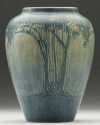Are Pottery Collectors Simply Too Picky?

But a chip on the rim of a piece of Rookwood? A hairline crack on a Newcomb bowl? A glaze bubble near the base of a piece of Grueby? Oftentimes that is all it takes to delegate an otherwise beautiful piece to the art pottery leper colony.
But is that designation deserved? Are we too picky when it comes to art pottery? And, if so, why?
Just as important, are there times when a chip, a hairline crack or a glaze flaw should be overlooked?
Jean Bragg (www.JeanBragg.com) offered this observation: “In my experience a serious pottery collector demands perfect pieces. If there is a minor defect or nick, he will insist that piece not be repaired. We know that perfect pottery pieces bring higher resale prices – and minor problems can devalue a piece. As for myself, I learned to never let a great piece get away because of a minor problem, such as a hair-line crack.”
David Rago (www.RagoArts.com) felt much the same way when he wrote, “Its obvious that a perfect pot will always be worth at least something more than the same piece with even a minor defect, but not all damage is created equally. There are many kinds of damage, some occurring while the pot was being made and some imparted once it left the kiln. And there are all kinds of collectors….”
He added a few examples. “A relatively minor surface flaw might reduce the value of a Rookwood vase by 50 percent. A small imperfection on a George Ohr [pictured] or Grueby vase might not even cause a reduction in value by 10 percent. In the case of the Arts & Crafts potter George Ohr, whose goal was to make ‘no two pots alike,’ collectors have the option of accepting a piece as it is – or not having it at all.”
Jim Messineo ( www.JMWGallery.com) replied, “The first thing that comes to mind when assessing any damage to a pot is ‘how rare a pot is it?’ Is it a one of a kind hand-made piece, or is it something that with time an identical perfect example can be found?”
Jim continued, “The other consideration in my mind is ‘what are the aesthetics of the pottery?’ The more pristine the type of ware, the more it seems that damage matters. For example, the market value for most Rookwood and Marblehead could be affected by as much as 50% by damage or repair. Conversely the value of a Grueby vase with tiny chips to the leaf edges would be affected very little.
“Imagine a continuum beginning with the most common piece of Roseville and ending with the rarest piece of Robineau. The value of the rare Robineau is likely to be little affected by condition, but the more common Roseville with any condition issue is likely to be greatly affected. The question for the buyer is ‘where on the scale does the piece fall?’
“The collector who rules out damage completely on rare, handmade potteries will be missing some great examples – and the collector of mass produced pottery who doesn’t pay close attention to condition may end up with a collection of little value if they try to sell it.”
Sound advise from experienced dealers and collectors.
Top Photo: Newcomb Pottery (www.ragoarts.com)
Bottom Photo: George Ohr (www.ragoarts.com)
For closeup details of pottery, simply place your cursor over the photographs.

